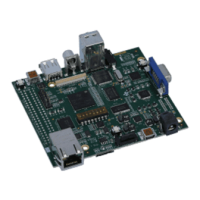Synchronous Serial Interface (SSI)
void ROM_SSIIntEnable (uint32_t ui32Base, uint32_t ui32IntFlags)
uint32_t ROM_SSIIntStatus (uint32_t ui32Base, bool bMasked)
void ROM_UpdateSSI (void)
17.2.1 Function Documentation
17.2.1.1 ROM_SSIBusy
Determines whether the SSI transmitter is busy or not.
Prototype:
bool
ROM_SSIBusy(uint32_t ui32Base)
ROM Location:
ROM_APITABLE is an array of pointers located at 0x0100.0010.
ROM_SSITABLE is an array of pointers located at ROM_APITABLE[2].
ROM_SSIBusy is a function pointer located at ROM_SSITABLE[14].
Parameters:
ui32Base is the base address of the SSI port.
Description:
Allows the caller to determine whether all transmitted bytes have cleared the transmitter hard-
ware. If false is returned, then the transmit FIFO is empty and all bits of the last transmitted
word have left the hardware shift register.
Returns:
Returns true if the SSI is transmitting or false if all transmissions are complete.
17.2.1.2 ROM_SSIClockSourceGet
Gets the data clock source for the specified SSI peripheral.
Prototype:
uint32_t
ROM_SSIClockSourceGet(uint32_t ui32Base)
ROM Location:
ROM_APITABLE is an array of pointers located at 0x0100.0010.
ROM_SSITABLE is an array of pointers located at ROM_APITABLE[2].
ROM_SSIClockSourceGet is a function pointer located at ROM_SSITABLE[15].
Parameters:
ui32Base is the base address of the SSI port.
Description:
This function returns the data clock source for the specified SSI. The possible data clock
source are the system clock (SSI_CLOCK_SYSTEM) or the precision internal oscillator
(SSI_CLOCK_PIOSC).
186 April 8, 2013

